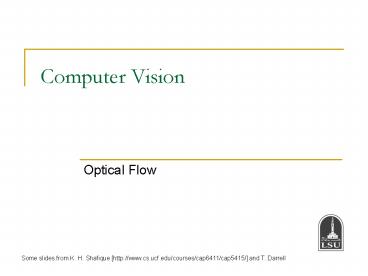Computer Vision - PowerPoint PPT Presentation
Title:
Computer Vision
Description:
... fine optical flow estimation Coarse-to-fine optical flow estimation Multi-resolution Lucas-Kanade Algorithm Block-Based Motion Estimation Block-Based Motion ... – PowerPoint PPT presentation
Number of Views:98
Avg rating:3.0/5.0
Title: Computer Vision
1
Computer Vision
- Optical Flow
Some slides from K. H. Shafique
http//www.cs.ucf.edu/courses/cap6411/cap5415/
and T. Darrell
2
Correspondence
- Which pixel went where?
Time t
Time t dt
3
Motion Field vs. Optical Flow
- Scene flow 3D velocities of scene points.
- Motion field 2D projection of scene flow.
- Optical flow Approximation of motion field
derived from apparent motion of brightness
patterns in image.
4
Motion Field vs. Optical Flow
- Consider perfectly uniform sphere rotating in
front of camera. - Motion field follows surface points.
- Optical flow is zero since motion is not visible.
- Now consider stationary sphere with moving light
source. - Motion field is zero.
- But optical flow results from changing shading.
But, in general, optical flow is a reliable
indicator of motion field.
5
Applications
- Object tracking
- Video compression
- Structure from motion
- Segmentation
- Correct for camera jitter (stabilization)
- Combining overlapping images (panoramic image
construction)
6
Optical Flow Problem
- How to estimate pixel motion from one image to
another?
7
Computing Optical Flow
- Assumption 1 Brightness is constant.
- Assumption 2 Motion is small.
(from Taylor series expansion)
8
Computing Optical Flow
- Combine
In the limit as u and v goes to zero, the
equation becomes exact
(optical flow equation)
9
Computing Optical Flow
- At each pixel, we have one equation, two
unknowns. - This means that only the flow component in the
gradient direction can be determined.
(optical flow equation)
The motion is parallel to the edge, and it cannot
be determined.
This is called the aperture problem.
10
Computing Optical Flow
- We need more constraints.
- The most commonly used assumption is that optical
flow changes smoothly locally.
11
Computing Optical Flow
- One method The (u,v) is constant within a small
neighborhood of a pixel.
Optical flow equation
Use a 5x5 window
Two unknowns, 25 equation !
12
Computing Optical Flow
- Find minimum least squares solution
Lucas Kanade method
13
Computing Optical Flow
- Lucas Kanade
- When is This Solvable?
- ATA should be invertible
- ATA should not be too small. Other wise noise
will be amplified when inverted.)
14
Computing Optical Flow
- What are the potential causes of errors in this
procedure? - Brightness constancy is not satisfied
- The motion is not small
- A point does not move like its neighbors
- window size is too large
15
Improving accuracy
- Recall our small motion assumption
- This is not exact
- To do better, we need to add higher order terms
back in
- This is a polynomial root finding problem
- Can solve using Newtons method
- Also known as Newton-Raphson method
- Lucas-Kanade method does one iteration of
Newtons method - Better results are obtained via more iterations
16
Iterative Refinement
- Iterative Lucas-Kanade Algorithm
- Estimate velocity at each pixel by solving
Lucas-Kanade equations - Warp H towards I using the estimated flow field
- - use image warping techniques
- Repeat until convergence
17
Revisiting the small motion assumption
- What can we do when the motion is not small?
18
Reduce the resolution!
19
Coarse-to-fine optical flow estimation
20
Coarse-to-fine optical flow estimation
run iterative L-K
21
Multi-resolution Lucas-Kanade Algorithm
22
Block-Based Motion Estimation
23
Block-Based Motion Estimation
24
Block-Based Motion Estimation
Hierarchical search
25
Parametric (Global) Motion
- Sometimes few parameters are enough to represent
the motion of whole image
translation
rotation
scale
26
Parametric (Global) Motion
- Affine Flow
27
Parametric (Global) Motion
- Affine Flow
28
Parametric (Global) Motion
- Affine Flow Approach
29
Iterative Refinement
- Iterative Estimation
- Estimate parameters by solving the linear system.
- Warp H towards I using the estimated flow field
- - use image warping techniques
- Repeat until convergence or a fixed number of
iterations
30
Coarse-to-fine global flow estimation
Compute Flow Iteratively
31
Global Flow
Find features Match features Fit parametric model
Application Mosaic construction
32
Image Warping
33
Image Warping
Interpolate to find the intensity at (x,y)
Pixel values are known in this image
Pixel values are to found in this image
34
Other Parametric Motion Models
Perspective
and
Pseudo-Perspective Approximation to perspective.
(Planar scene Perspective projection)































